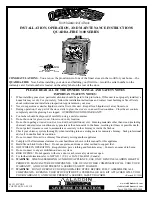
16
© 2021 United States Stove Company
CREOSOTE FORMATION, INSPECTION, &
REMOVAL
CAUTION:
THE EXHAUST SYSTEM SHOULD BE CHECKED
MONTHLY DURING THE BURNING SEASON FOR
ANY BUILD-UP OF SOOT OR CREOSOTE.
When any wood is burned slowly, it produces tar and
other organic vapors, which combine with expelled
moisture to form creosote. The creosote vapors condense
in the relatively cool chimney flue or a newly started
fire or from a slow-burning fire. As a result, creosote
residue accumulates on the flue lining. When ignited, this
creosote makes an extremely hot fire, which may damage
the chimney or even destroy the house. Despite their high
efficiency, pellet stoves can accumulate creosote under
certain conditions. The chimney connector and chimney
should be inspected by a qualified person annually or per
ton of pellets to determine if a creosote or fly ash build-
up has occurred. If creosote has accumulated, it should
be removed to reduce the risk of a chimney fire. Inspect
the system at the stove connection and at the chimney
top. Cooler surfaces tend to build creosote deposits
quicker, so it is important to check the chimney from
the top as well as from the bottom. The creosote should
be removed with a brush specifically designed for the
type of chimney in use. A qualified chimney sweep can
perform this service. It is also recommended that before
each heating season the entire system be professionally
inspected, cleaned and, if necessary, repaired. To clean
the chimney, disconnect the vent from the stove.
FLY ASH
This accumulates in the horizontal portion of an exhaust
run. Though non-combustible, it may impede the normal
exhaust flow. It should therefore be periodically removed.
ASH REMOVAL & DISPOSAL
CAUTION:
ALLOW THE STOVE TO COOL BEFORE PERFORMING
ANY MAINTENANCE OR CLEANING. ASHES
MUST BE DISPOSED OF IN A METAL CONTAINER
WITH A TIGHT FITTING LID. THE CLOSED
CONTAINER OF ASHES SHOULD BE PLACED ON
A NON-COMBUSTIBLE SURFACE OR ON THE
GROUND, WELL AWAY FROM ALL COMBUSTIBLE
MATERIALS, PENDING FINAL DISPOSAL.
Ashes should be placed in a steel container with a tight
fitting lid. The closed container of ashes should be placed
on a noncombustible floor or on the ground, well away
from all combustible materials, pending final disposal. If
the ashes are disposed of by burial in soil or otherwise
locally dispersed, they should be retained in the closed
container until all cinders have been thoroughly cooled.
SMOKE AND CO MONITORS
Burning wood naturally produces smoke and carbon
monoxide(CO) emissions. CO is a poisonous gas when
exposed to elevated concentrations for extended
periods of time. While the modern combustion systems
in heaters drastically reduce the amount of CO emitted
out the chimney, exposure to the gases in closed or
confined areas can be dangerous. Make sure you stove
gaskets and chimney joints are in good working order
and sealing properly to ensure unintended exposure. It is
recommended that you use both smoke and CO monitors
in areas having the potential to generate CO. A working
smoke detector must be installed in the same room as
this product. Install a smoke detector on each floor of
your home; incase of accidental fire from any cause it
can provide time for escape. The smoke detector must be
installed at least 15 feet (4,57 M) from the appliance in
order to prevent undue triggering of the detector when
reloading.
CHECK & CLEAN THE HOPPER
Check the hopper periodically to determine if there is any
sawdust (fines) that is building up in the feed system or
pellets that are sticking to the hopper surface. Clean as
needed.
DOOR AND GLASS GASKETS
Inspect the door and glass window gaskets periodically.
The door may need to be removed to have frayed, broken,
or compacted gaskets replaced by your authorized dealer.
This unit’s door uses a 0.125 x 1” flat gasket. Inspect and
clean the secondary burn plate, primary burn basket,
primary burn tube and ashtray prior to igniting the stove.
Do not operate your stove with the viewing door open,
safety concern may arise. The feed door must be closed
and sealed during operation.
PAINTED SURFACES
It is highly recommended that the initial burn of your new
stove be done outdoors. The paint used to coat your stove
a high temperature paint that is dry upon arrival but has
a final cure that happens during the initial burn. This
cure will last 20-30 minutes and will produce fumes and
some smoke.
MAINTENANCE
















































